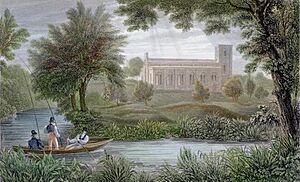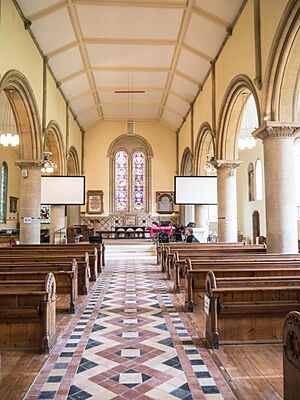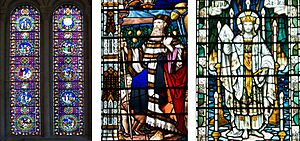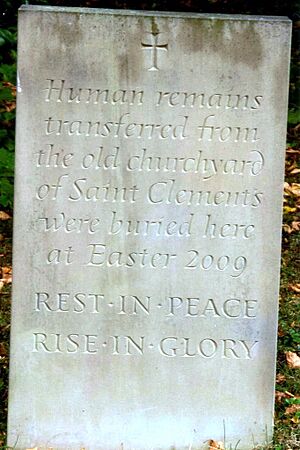St Clement's Church, Oxford facts for kids
Quick facts for kids St Clement's |
|
|---|---|
| St Clement's Parish Church | |

The present church, completed in 1828, viewed from the east
|
|
| Location | Marston Road, Oxford OX4 1FN |
| Country | England |
| Denomination | Church of England |
| Churchmanship | Evangelical |
| History | |
| Founded | Before 1122 |
| Dedication | Clement, Bishop of Rome (died c.100 AD) |
| Architecture | |
| Architect(s) | Daniel Robertson |
| Style | Romanesque Revival (Anglo Norman) |
| Years built | 1825–1828 |
| Administration | |
| Deanery | Cowley |
| Archdeaconry | Oxford |
| Diocese | Diocese of Oxford |
| Province | Province of Canterbury |
St Clement's Church is a Church of England parish church located just east of central Oxford, England. It is an evangelical church, meaning it focuses on the Bible and sharing the Christian faith.
Contents
History
The church building you see today was built in the 1820s. It replaced a much older church that was taken down in 1829.
The Old Church
The first St Clement's Church stood near what is now The Plain roundabout. This is where roads from London and Henley cross the River Cherwell at Magdalen Bridge. The church served a small community called Bruggeset, which means "Bridge Settlement." It also served the countryside that later became East Oxford.
The church was first mentioned in writing in 1122. At that time, King Henry I gave it to St Frideswide's Priory. Some experts think the church might have been built by a Danish army between 1016 and the 1050s. This would explain why it was near a bridge and dedicated to St Clement, which was unusual for churches away from the coast back then.
We don't know much about what the very first church looked like. However, a stone head now in the Ashmolean Museum might have been a colorful stone decoration from the church in the 1200s. This suggests the early church was very colorful inside.
In 1323, money was given to rebuild the church. Most of the building taken down in 1829 was from this time. In 1773, John Peshall described the church as having one main area and a small tower with three bells. The churchyard was made bigger in 1781. In 1816, the small tower was replaced with a square one.
Civil War Times
During the Siege of Oxford (1644-1646), St Clement's church and its area were right on the front line. This was between the King's forces in the city and the Parliament's army on Headington Hill. Because of this, the area suffered a lot. Many streets were destroyed to build defenses or to stop the enemy from hiding. The Black Horse Inn and the church were among the few buildings that survived.
Growing Community
In the early 1800s, Oxford grew quickly. Many new houses were built in the St Clement's area between 1821 and 1824. The old church was small, only seating 250 people. Services were also noisy because of carriages passing by. So, people decided to build a new, larger church in a new location.
Since the rector, Revd John Gutch, was in his 80s, a helper (curate) was appointed. This curate would also help raise money for the new church.
John Henry Newman, who later became a very important religious leader, became the curate in 1824. Even though he was only there for two years, Newman made a huge difference. He visited every home, started a Sunday school, and preached to a full church.
The New Church
Thanks to Newman's efforts, the current church was built between 1825 and 1828. It cost over £6,000. The land was given by Sir Joseph Lock, a local banker. The church was designed in an Anglo-Norman style, which looks like old Romanesque buildings. This style was chosen because it was more affordable.
The architect was Daniel Robertson. St Clement's is an early example of this Anglo-Norman or Romanesque Revival style. The architect thought the new church could seat up to 1024 people. The church was placed where it is now because people expected new houses to be built along Marston Lane (now Marston Road).
Marriages and the Law
St Clement's was the first church in Oxford built on a new site since the Middle Ages. Because of its new location, it didn't automatically become the official parish church when it was opened in 1828. This wasn't realized at the time. So, a special law had to be passed in 1836 to make sure all the marriages that had happened in the new church were legal.
Church Building Changes (1800s-2000s)
The inside of the church was greatly updated in the 1870s. In 1871, the old wooden seats were replaced with the current ones. The West Gallery, a balcony area, was removed in 1876. These changes were mostly paid for by the wealthy Morrell family, who owned a brewing company. They were very involved with St Clement's for many years.
In the late 1900s and early 2000s, more changes were made. These included adding a nursery and kitchen (1973), creating a raised area for the altar (1984), and adding disabled access (2005). Between 2020 and 2022, the organ and some pews were removed to create a more flexible space. The kitchen was also improved.
The Present Day
The people who attend St Clement's today come from all over Oxford. They represent many different ages and backgrounds.
Besides the church building, many church and community activities happen at St Clement's Centre on Cross Street.
St Clement's usually has Sunday services at 10:30 AM and 6:30 PM. Children and young people can join the morning service with their families or have their own activities at St Clement's Centre. During the week, there are:
- Home groups (small Bible study groups)
- Youth activities
- A popular Baby and Toddler Group
- Café Club for older people
St Clement's also works with the Oxford Churches Debt Centre to help people with financial difficulties.
The church has a team of staff, including the Rector, Revd Mark Hay (who started in April 2024), and two Assistant Curates. Many volunteers also help with daily activities.
Bells
St Clement's has three bells. All of them were brought from the old church in the 1820s. The two largest bells are now on display in the church entrance.
- The biggest bell is about 55.6 cm (21.5 inches) wide. It was made in 1636.
- The second bell is about 52 cm (20.5 inches) wide. It is thought to be from the late 1200s, making it the oldest bell in Oxford.
- The small bell is the only one still in the tower, but it is not rung. It was made in 1731.
Music
The first professional musician mentioned in church records was a clarinet player in 1843. St Clement's bought its first organ in 1846. It was moved in 1876 when the West Gallery was taken down.
A new organ was built between 1897 and 1899. The old organ was sold to St Paul's Church (now Freud's nightclub). The new organ was first used for Queen Victoria's Diamond Jubilee in 1897. It was updated over the years, but by the late 20th century, it was not used much due to maintenance costs and changes in worship style. It was removed in early 2020.
Since the late 1900s, music for services has mainly been provided by a worship group. They use both traditional and electronic instruments. The church also uses modern worship songs along with older hymns. During the pandemic in 2020-2021, musicians recorded music from their homes for online services.
Windows
The beautiful east window at the front of the church shows ten scenes from the life of Jesus. It was made by Isaac Hugh Russell, a talented artist, and installed in 1847.
The four north windows show scenes about faith. They were made in 1865 for another church and moved to St Clement's in 1896.
The "Seven Churches" window in the north-west corner was given in memory of George Herbert Morrell. It shows scenes based on letters to seven churches mentioned in the Bible. This window was designed by Powell & Sons and installed in 1908.
The south windows are made of plain glass. Between 2018 and 2021, the church cleaned and repaired its windows. This included restoring a window that had been partly taken apart when a nursery room was built.
Churchyard
The churchyard around the new church was originally small. In 1879, the Morrell family gave more land to make it bigger. They gave even more land in 1920, which now forms the main part of the churchyard. This 1920 extension also provided space for a war memorial. The memorial was dedicated on April 4, 1921. Inside the church, a scroll lists the names of men from St Clement's who died in the First and Second World Wars.
The old churchyard at The Plain was used until the 1870s. In 1939, the City Council took it over. Any remaining gravestones were moved to the top of the current churchyard in 1950. Human remains found during roadworks at The Plain were respectfully reburied in the new churchyard in 1950 and 2009.
The churchyard is part of a "green corridor" in Oxford. It is slowly being developed into a peaceful place for visitors and a home for wildlife. Woodpeckers, jays, robins, and even deer are often seen there.
Charities
St Clement's Church is connected to two charities. The Rector of the church is in charge of both.
The Charity of Thomas Dawson
This charity was started in 1521. It owns property in St Clement's, and the money it earns is used for good causes. The charity helps people in need in the St Clement's area. It also supports education in Oxford and helps maintain St Clement's Church.
St Clement's Community Property
This group, started in 2021, owns and takes care of a few properties. These include St Clement's Centre on Cross Street and The Old Mission Hall.
Schools (1839–1958)
In 1839, the church leaders bought a building and turned it into schools for boys, girls, and young children. This was because the local population was growing. Over the years, the schools moved to different locations as they grew and changed. Eventually, in 1958, the last of the St Clement's schools closed. The Cross Street site, where the boys' school was, is now used by St Clement's for church and community activities.
Parish Records
Most of St Clement's old records are kept at the Oxfordshire History Centre. Some records, like baptisms, marriages, and burials, can be found online. These records go back to the 1600s.
List of Clergy
From 1122 until the 1530s, priests for St Clement's were chosen by St Frideswide's Priory. After the English Reformation, the right to choose priests passed to the King or Queen for a long time. Since the mid-1800s, it has been held by trustees who follow the Evangelical tradition of the Church of England.
Rectors, 21st Century
- 2024 Mark Hay
- 2015-2023 Rachel Gibson
Rectors, 20th Century
- 1992-2014 Bruce Gillingham
- 1969-1991 David Henry Ryder Bishop
- 1955 Peter John Garnett Cottingham
- 1947-1954 Hon. Jonathan Malcom Atholl Kenworthy
- 1937-1947 Arthur Murray Thom
- 1919-1936 Leslie Bradyll-Johnson
- 1913-1918 Thomas W Gilbert
Rectors, 19th Century
- 1878-1911 Francis Pilcher
- 1878 Henry Fermoy Dernford
- 1861-1877 John Thomson Darby
- 1858-1861 Edward Arthur Litton
- 1850-1855 William Strong Hore
- 1831-1850 John William Hughes
Rectors, 18th Century
- 1795-1831 John Gutch
- 1767-1795 Samuel Weller
- 1760-1767 John Bilstone
- 1751-1760 James Cosserat
- 1734-1751 Francis Webber
- 1724-1734 John Conybeare
- 1722-1724 John Evans
Rectors, 17th Century
- 1696-1722 Joseph Harwar
- 1682-1696 Robert Harsnett
- 1679-1682 Humphrey Prideaux
- 1674-1679 Gilbert Wharton
- 1661-1672 Samuel Nalton
- 1630-1641 William Chidley
- 1610-1630 Thomas Westley
- 1606-1610 Robert Lloyd
- 1604 Tobias Berricke
Rectors, 16th Century
- 1589-1592 Thomas Lodington
- 1578-1585 Robert Briant or Bryan
- 1575 Peter Pott
- 1567-1575 William Edwards
- 1561-1567 Geoffrey Vaughan
- 1557 Nicholas Pullen
- 1554-1557 William Sale
- 1540 M John Powel
- 1523 M William Bays
- 1519 M Oliver Stonying
- 1516 M Richard Wynnesmore
- 1500 William Worcester
- 1500 M John Gorle
See also






